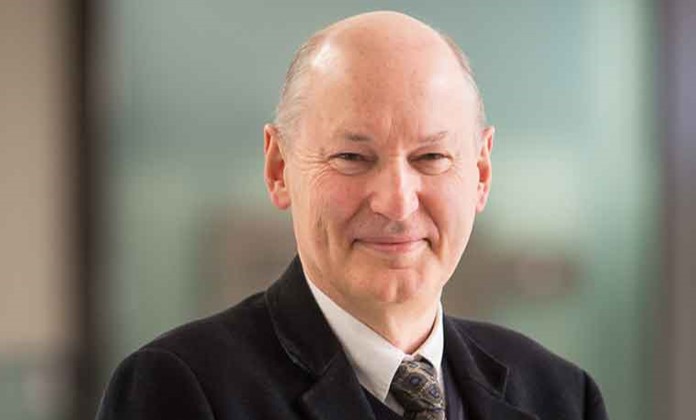Laureate Professor Eric Reynolds reflects on 15 years at Bio21

In 2003 my research group was in the old Royal Dental Hospital of Melbourne at 711 Elizabeth St, now the site of the Victorian Comprehensive Cancer Centre. We had received funding from the State Government as part of the Science, Technology and Innovation Initiative (STII) and Federal Government through its CRC program to establish a Centre for Research on Oral Health (Oral Health CRC). This funding resulted in a significant expansion of my research group which meant we could not be fully accommodated in the new dental hospital building at 720 Swanston St. I was very fortunate that the Bio21 Institute’s Inaugural Director Professor Dick Wettenhall and the DVCR/VC were supportive of providing my group unfitted-out space on Level 3 North of the Institute building. I was also fortunate that John Brumby, the relevant Minister at the time was happy for me to use some of the STII funds to fit-out the space to our specific design to accommodate my research group. We were working on several projects but a major project involving our commercial partner CSL was the development of a vaccine for Porphyromonas gingivalis to treat moderate to severe forms of periodontitis.
Periodontitis is a chronic inflammatory disease of the supporting tissues of the teeth and severe forms result in tooth loss and have been linked to increased risks of other diseases, like dementia, rheumatoid arthritis, diabetes, cardiovascular diseases and certain cancers. Periodontal diseases start when poor oral hygiene allows dental plaque to accumulate at the gum margin. This, if left undisturbed, results in gum inflammation which causes it to swell and form a periodontal pocket. This pocket becomes anaerobic and together with inflammation can result in an increase in microbial diversity in the pocket and a process now described as dysbiosis (perturbation of homeostasis). This dysbiosis usually results in the slow destruction of the tooth supporting tissues to produce a deeper and more anaerobic pocket. Under certain conditions at the base of this dysbiotic pocket a “keystone” pathogen called P. gingivalis can emerge to produce an opportunistic polymicrobial infection which results in rapid periodontal bone loss to produce severe periodontitis. The base of the pocket becomes ulcerated which allows invasion of the pathogen into the bloodstream and establishment at remote sites like the brain, coronary arteries, pancreas etc. We have shown that P. gingivalis can produce the same disease pathology in animal models of periodontitis using the Bio21 BRF facility. Also, using the animal model and P. gingivalis mutants we have shown that the surface proteinase Lys-gingipain is a major virulence factor causing dysregulation of the immune response and destructive inflammation. Targeting this virulence factor with a chimeric recombinant therapeutic vaccine can neutralize the proteinase and stop disease progression.
With funding from NH&MRC and ARC we have been studying mechanistically how P. gingivalis emerges at the base of a periodontal pocket and causes disease immunopathology. This research has also included how it secretes and attaches Lys-gingipain to the cell and vesicle surface using a novel secretion machinery.
Similar to what Phil Batterham described in his May 2020 Bio21 Guest Message our time at the Bio21 Institute has been enriched by generous and collegial collaborations with other Bio21 researchers who have enabled us to achieve much greater impact than we would have if we worked alone. We worked with Mike Gorman and Michael Parker to determine the crystal structure of the Lys-gingipain proteinase which has helped map neutralizing antibody epitopes onto the 3D structure. Malcolm McConville collaborated with us to demonstrate that the presence of P. gingivalis could benefit other bacterial species in the periodontal pocket through metabolic symbioses. Eric Hanssen introduced us to single particle cryo-EM to analyze the structure of 50 nm rings of the novel protein transport system of P. gingivalis that secretes Lys-gingipain to the cell surface; and most recently Richard O’Hair helped us characterise the novel sugar linker that P. gingivalis uses to attach Lys-gingipain onto LPS on the cell and vesicle surface. There is little doubt that these collaborations have improved the quality of our research. I am profoundly grateful to every Bio21 colleague who has helped us on our research journey over the last 15 years.
On reflecting on the impact of our research I cannot conclude without mentioning the current COVID-19 pandemic. What is interesting is that many of the risk factors associated with severe outcomes of SARS-CoV-2 infection are similar to those of severe periodontitis. Periodontitis is an age-related progressive disease with 50% of dentate individuals over the age of 65 showing moderate to severe forms of disease. Furthermore, periodontitis severity is strongly linked with comorbidities and poor general health. Aspiration of periodontal pathogens by people with periodontitis can lead to pneumonia and periodontal pathogens can be found in sputum samples from those infected with SARS-CoV-2. This is consistent with reports that treatment of COVID-19 complications with a combination of antiviral drugs and antibiotics can improve treatment outcomes. This has led to the suggestion that severe complications of COVID-19 could result from synergism between SARS-CoV-2 and opportunistic bacterial pathogens, potentially aspirated by a patient with periodontitis, to result in a superinfection.
I will leave you with a thought also inspired by reading Phil Batterham’s Guest Message where he quoted Dirty Harry. I will also quote Dirty Harry who received an in-the-face berating from his superior in The Enforcer to which he replied: “Your mouthwash ain’t making it”. Unfortunately, once you have severe periodontitis with infected periodontal pockets as a source of an invading pathogen, mouthwash or indeed any oral care product will not help eradicate the pathogen. Only professional treatment can remove the pathogen. However, modern oral care products with effective oral hygiene procedures (flossing and brushing) can help prevent the onset of periodontitis or recurrence of infection after treatment. In the time of COVID-19 it is even more imperative to keep healthy and that includes oral health so please assiduously maintain your daily oral hygiene procedures!